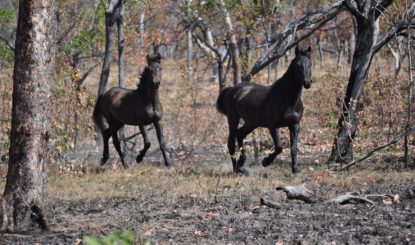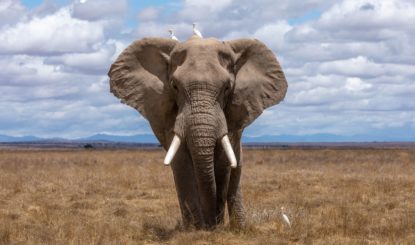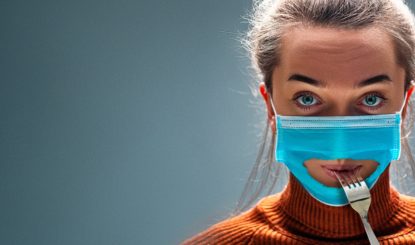Wintertime on the Franz Weber Territory in Australia
June to August is winter time in Australia! And with that the cool-dry season on Bonrook with the most temperate weather of the year. Warm days of 30 degrees and cool nights down to 9 degrees, no rain or humidity. The skies are ultra-blue, little to no clouds. The cool south-easterly zephyr breezes through Bonrook every morning, originating from the Antarctic.
During this season of winter the brumbies are at their best! They are fat and well-nourished, their coat and mane is supple and sleek. The foals from last year have grown up to healthy yearlings. Due to this year’s heavy wet season, we anticipate a healthy number of new foals around October and November. Green, lush grass and water is still abundant throughout the Franz Weber Territory.
“Winter usually marks the end of the burn off season. I just spent the last six weeks conducting controlled burn offs to manage any potential fire risks later in the year.”, explains Sam. Normally, the burn off takes at least two months ad is conducted during April and May while the ground is still moist and the creeks and rivers are still holding water preventing the fire from spreading. But due to the biggest wet season in 16 years with a total rain fall of 1,675mm on Bonrook, the land was covered with an abundance of dense, dried-up grass which made it burn faster and more thoroughly.
The Last Burn-Off
“This is the last part of the burn off until April next year. We get a permit from the Northern Territory Government to conduct burn offs every year, usually valid from April till June.”, confirms Sam while casually flicking a burning match into dry, yellow grass field. He continues: “There is no risk that this fire will get out of control as it is surrounded by previously burnt ground, swamps and a creek”.
While the grass is now mostly cured, the dry-season plants and flowers are flourishing and in full bloom. Such as the Australian-native Rosella (Hibiscus sabdariffa) with its fire-red flowers that are ideal to make jam with or to put straight into a glass of champagne! The pink Turkey bush (Calytrix exstipula) thrives in sandy soil and disturbed earth, such as beside roads, walking tracks and paths. And the Great Bowerbird likes to build his exquisite nest under it!
While the plant has no leaves, the yellow flowers of the native kapok bush (Cochlospermum fraseri) are currently blooming brightly. The fibres in its seed pods are eight times finer than cotton and have been used as natural fibre for the stuffing of mattresses and pillows for decades. Blooming in bright orange at this time of the year is the native Fern-leaved Grevillea (Grevillea pteridifolia). Although non-native to Australia, pink Bougainvilleas decorate the gardens around Bonrook’s Homestead, and the majestic African Mahogony trees are lush and green and provide valuable shade to the old riding horses, brumbies, and many native animals on the Franz Weber Territory.
Diverse Terrain on the Franz Weber Territory
Standing on the top of Bonrook’s highest hill (232m), looking out on to the vast open woodland savanna, the property seems to be very routine, simply like a uniform forest. But driving through the land, it becomes clear that this terrain is very diverse. Bonrook consists of a vast variety of landscapes: soft grass pastures, rocky outcrops, granite sand, grey soils, red soils, gravel tracks, swamps, a vast variety of Eucalyptus and Tea trees and other native trees, bushes and shrubs. The entire property is dissected by a vast array of creek systems, billabongs, Paperbark swamps, and the Cullen River tributaries.
Another interesting part of this land are the countless, huge termite mounds – called Cathedral mounds – that strikingly stand tall all over the Franz Weber Territory. The structure of these mounds can be very complicated. Inside the mound is an extensive system of tunnels and conduits that serves as a ventilation system for the underground nest. In order to get good ventilation, the termites will construct several shafts leading down to the cellar located beneath the nest. “The termites constantly build and repair the mounds; they grow up to 6 metres in height here on Bonrook. Each mound has one queen and is active for up to 50 years. When the queen dies, the colony abandons the nest and as a result, the mound starts to decay.”, explains Sam.
The Star of the Show
At the moment, the special attraction on Bonrook is a very interesting little bird: the hooded parrot (Psephotellus dissimilis). This medium-sized parrot, up to 26 cm long, is a species of parrot native to the Northern Territory, in particular to the Pine Creek area. It is found in savannah and open woodland and has a very peculiar breeding ground: termite mounds! “The Franz Weber Territory is its ideal habitat with its many huge termite mounds.”, says Sam. The hooded parrots dig an entry hole in the top part of the mound – always from the east side – and create a big open space inside the mound to lay their eggs. The nest is high enough in the termite mound to be safe from predators such as dingoes and snakes.
Furthermore, the solid mound walls made from soil by the termites protect this smart and refined nest’s eggs and fledglings from bush fires. Hooded parrots will not use the same termite mound to nest in the following year. Though being territorial, they will choose another one in the vicinity. The striking looking male has a black head, a bright turquoise body, a brown back, brown and yellow wings, and an olive green and blue tail. The female is a dull-green parrot with a grey-brown head and pink undertail coverts. The hooded parrot is truly the star of the show at the moment! A TV production company from the UK just spent two weeks on Bonrook in March and May to film this extraordinary nest-builder for their wildlife show.
Even Horses Need to Go to the Dentist
Back in April of this year, Sam went to the dentist in the nearby town of Katherine with the two old riding horses Dizzy (16) and Pepper (17). Both were found to have reasonably good teeth for their age, but had to get small spurs and hooks filed off their cheek teeth. Additionally, Pepper had to have one upper incisor removed that was loose and damaged which bothered him when eating. “Over a period of time, I noticed Pepper spilling big amounts of food from his feed bucket. So I knew something wasn’t right with his teeth.”, remembers Sam.
In June it was Red’s turn to go see the dentist. “Given his high age of 20 years, I knew it’s time for him to see the dentist”, explains Sam. The dentist found also Red’s teeth to be in good condition given his high age; some small spurs and hooks had to be filed off his cheek teeth.
Domestic horses can have problems with their teeth even at a young age due to living on processed feed, lack of access to natural, fresh grass, and spending less time chewing due to set feeding hours.
The old riding horses on the Franz Weber Territory are domestic but live free range. About only one hour a day they spend in the stables to eat their breakfast ration, while the rest of the day and night they roam around freely and graze on the native grasses of the 2.5 km2 large pasture paddocks.
Brumbies on the other hand, don’t need to go to the dentist. They naturally have very good and healthy teeth because they live and eat as nature has intended – grazing freely on tough native grasses for up to fourteen hours a day. Hence, no spurs or hooks grow on their cheek teeth and are not known to have any dental issues.
Happy 25th Bonrook-Anniversary to our Station Manager, Sam Forwood!
Growing up on a farm in rural South Australia, Sam Forwood first came to the Northern Territory in 1973 with his parents and siblings. He went to school in Darwin and later in Adelaide. His whole life he worked on stations and farms in the Northern Territory, apart from 5 years serving full-time in the Australian army.
Sam has been horse riding since the age of five, and so has been in the saddle for over 50 years now. Sam came to Bonrook the first week of July 1996. He was originally hired for a short-term role to fix fences around the property. It wasn’t long until he took over the trail horse ride operation for tourists and started to manage the wild horse sanctuary.
Vera and Judith Weber were impressed with Sam’s diverse skillsets, his personality, and knowledge of the land, horses and other animals. In November 1996, they offered him the position of the Bonrook Station Manager.
Sam has been part of the evolution and operational changes on Bonrook, such as the transformation from Bonrook Lodge, to the Hotel Resort, to the Bed and Breakfast, through to running solely a wild horse sanctuary. He also experienced the change of leadership from Franz and Judith Weber to Vera. “Back in the old days, the only way to communicate with the foundation in Switzerland was by landline phone or fax. And today, I can send and receive emails while on horseback in the middle of the bush.”, laughs Sam.
A big thank you to Sam from the whole Fondation Franz Weber team for his immense loyalty, dedication, passion for horses and wildlife, and continuous work for the Franz Weber Territory and all its animals!
More information:
- Our project page “Wild Horse Sanctuary in Australia”
- This article was first published in the Journal Franz Weber 137. You can find the PDF version of all previous magazines here.
- You have not yet subscribed to our quarterly magazine, the Journal Franz Weber? Order the latest issue for free here (in German and French only).


